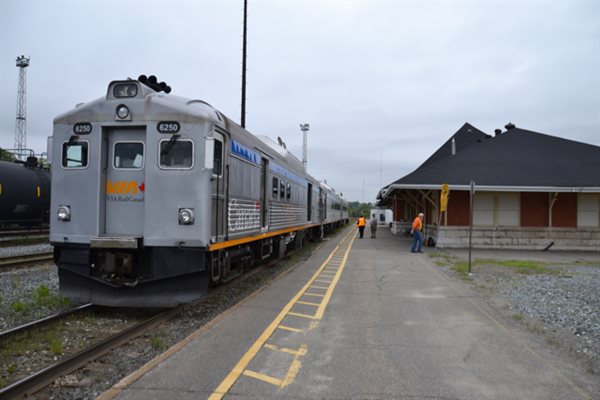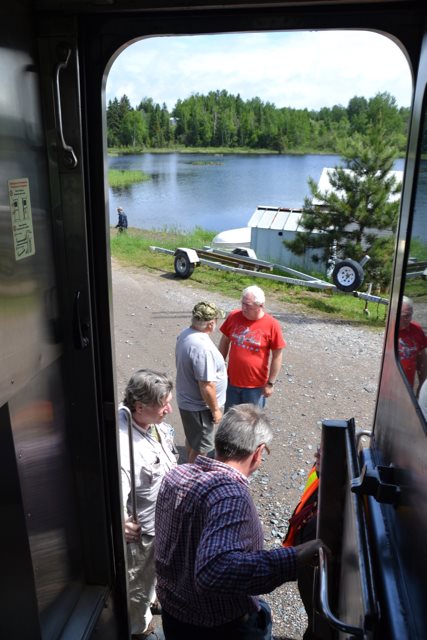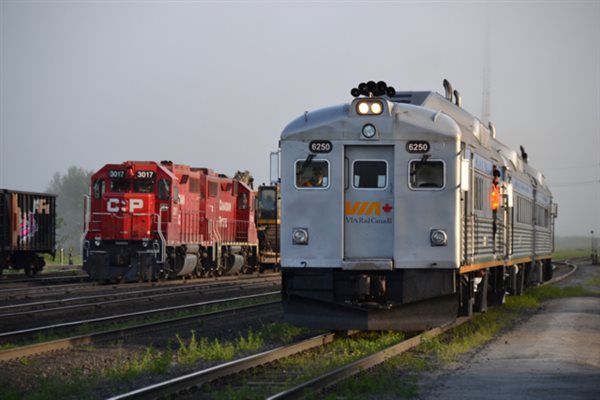VIA Rail Canada’s Sudbury-White River train (formerly known as the Lake Superior), consisting of two (sometimes three) Budd-built Rail Diesel Cars (RDCs) that operate three days a week in each direction along a 301-mile section of Canadian Pacific’s transcontinental main line, is the only passenger train of its kind in North America for several reasons. It is currently the only regularly scheduled intercity passenger service using Budd RDCs (the only others being used as backups on two commuter lines, Tri-Met’s Westside Express in Oregon and Trinity Railway Express in Texas, and on a handful of excursion trains). It is the only intercity passenger train in Canada that uses Canadian Pacific trackage for a significant stretch (western Canada’s privately-run Rocky Mountaineer excepted). And it is one of three passenger train routes in northern Ontario that delivers people, supplies and equipment to points along the line that are not accessible by road (except for a few dirt logging roads) or air (except for a few wilderness lodge sites that have small landing strips for bush planes). I had the opportunity to travel aboard this service — whose parallel cannot be found on this side of the 49th Parallel — last week (June 18 & 19).
VIA Train 186 pauses inside a Canadian Shield rock cut just east of CP's diamond with the Algoma Central Railway at Franz, Ontario on June 19. All photos by Malcolm Kenton.
VIA refurbished all three of the RDCs within the past year, giving them new seats, electric outlets at each seat, restrooms, heating & air conditioning systems, and wheelchair accessibility features. One car has a large restroom whose doors slide open or closed and lock with the push of a button. A crew member on my trip referred to it as “the Cadillac bathroom.” Next to the engineer’s cab on each coach is an area that doubles as a baggage area and a crew break area, with refrigerator, sink and coffee maker. The highest passenger train speed limit on the route is 75 mph, reached for just a brief stretch between Sudbury and Cartier. Otherwise, it generally tops out at 60 — though on rare occasions where the train has had to run with just one RDC, it is limited to 45 mph — meaning the trip is usually completed just barely within the engineers’ legal limit of 12 consecutive hours of service, between which periods crews must be given at least eight consecutive hours of rest.
The vast majority of passengers on “the Budd cars” (as most locals refer to the train) — usually only a handful on each trip, though occasionally all 48 seats on both cars are occupied for a portion of the trip — are visiting remote cabins along the line to fish, hunt/trap, canoe or kayak, mountain bike, or otherwise enjoy the great outdoors. There are also year-round residents of the mid-route communities of Ramsey and Chapleau who use the train to visit family and friends and go to medical appointments in Sudbury (as there are no medical specialists in their hometowns). Passengers bring aboard an array of gear for wilderness expeditions — canoes, fishing gear, coolers, etc. — which is loaded into the baggage section of one of the RDCs (in the busy season, a third RDC car is added that is solely a baggage car, as was the case on my jaunt). And owners of cabins and retreats near the line use the train as a parcel service, having others buy groceries and supplies at one of the endpoints and drive them to the train, to be loaded into the baggage hold and unloaded at the stop nearest their outpost.
Patti and Bob Fitzgerald in front of their cabin in Woman River, Ontario, having just disembarked from VIA train 185 from Sudbury on June 18.
On my westward journey from Sudbury to White River on June 18, I was joined by a group of 25 elementary school students and their four chaperones who boarded from downtown Sudbury’s mostly empty original CP depot. They sat in the forward car (the other passengers and I were in the middle car of the 3-car train) and detrained 30 miles west at Cartier, where a school bus ferried them back to Sudbury. The other passengers were a group of four middle-aged men who got off at the tiny hamlet of Biscotasing for a weekend of fishing, and a couple — who introduced themselves as Bob and Patti Fitzgerald — who were going from their home in Capreol (just north of Sudbury) to their cabin just a few steps from the tracks in Woman River, Ontario. That locale, Patti told me, used to be a bustling railroad town of around 120, with a school, a church, a bank and a post office. Now, the Fitzgeralds’ second residence “in the bush” is all that remains — and without the VIA train, they would have absolutely no way of reaching it.
After we saw them off at Woman River, I was the only paying passenger on board the train for the next 137 miles (traversed in a little under three hours, including a couple of sidings we took for eastbound freights), until we stopped at milepost 88 (just west of Franz) to pick up a family of eight men of three generations living in different parts of the US, who were returning to White River, where they parked their van, after three days of fishing at a wilderness retreat. (The next morning’s eastbound Budd cars would ferry groceries from White River to the same camp.) Until we reached them, though, it was just me and the crew of three, winding along through the forest, past numerous lakes and meandering rivers and through rock cuts in the Canadian Shield. The only visible construction work on this stretch, other than the railroad itself, were hundreds of beaver dams and lodges. The only stop we made on that section (other than waiting for eastbound freight trains) was 15 minutes (five minutes for each car) to refuel the RDCs from a diesel truck at Champleau, followed by a 5-minute stop at the utilitarian station (also a CP crew office) while the engineers picked up train orders for the next CP subdivision. All the intermediate stops on this route are flag stops, which are bypassed if no passengers are confirmed as boarding or detraining. Only Sudbury, Cartier, Chapleau and White River have station buildings or platforms (and White River’s waiting area was permanently closed) — elsewhere, passengers board and detrain at grade crossings, or simply onto the ballast.
Supplies bound for bush lodges located at Milepost 88 are loaded onto the RDC baggage car of VIA train 186 next to the CP depot in White River, Ontario just before 7:00 AM on June 18.
The crew consisted two qualified engineers (one of whom doubled as a baggageman) and a Service Manager. Since VIA lacks the passenger conductors with whom stateside passengers are familiar (having done away with the position in 1990 following intense negotiations with labor unions — now the engineers are members of the Teamsters Rail Canada Conference and the Service Managers are nonunion), the Service Manager handles all passenger-related duties, including selling and collecting tickets, ensuring passenger safety, and selling food and beverage. Only the previous week did VIA begin offering any food service on the Budd cars. Now, coffee, tea, bottled water, candy bars, chocolate covered raising, and Pringles chips are offered for sale: $2.25 (Canadian dollars) per cup for coffee or tea; $2.00 per package for everything else.
This was also the first passenger train I have ever ridden on which the crew asked a passenger (me, on the westbound trip) to volunteer to be shown how to open and close the vestibule doors, in order to assist the crew in case of emergency. The Service Manager also gave all passengers a thorough safety briefing, and said this was all in accordance with Transport Canada (the federal government’s transportation ministry) regulations.
My westbound train arrived in White River just under two hours late, at 6:55 PM. CP treated our train similarly to the way Canadian National treats VIA’s Canadian, with freight seemingly given absolute priority. We waited on sidings five times for eastbound freight trains that were each over a mile long, consisting of double-stack containers, covered hoppers, tank cars and auto racks. The last such delay occurred just 7 miles east of White River, and lasted 45 minutes.
Upon arrival, the Service Manager (with whom I had conversed at length on board) gave me directions for the 15-minute walk through the town (which lacks sidewalks) to the main highway, where my motel was located. Being so far west in the Eastern time zone on one of the year’s longest days, sunlight remained until 10:30 PM. I had both dinner and breakfast the next morning at the same family-run restaurant next to the hotel, and awoke just after dawn on June 19 to board the same Budd consist for a 7:00 AM eastbound departure. On this trip, I had a swift 1-hour, 15-minute ride to the junction point of Franz, where I was allowed to wait in a small trackside shelter occasionally used by CP maintenance of way workers for three hours to catch the southbound passenger train on the Algoma Central Railway. More about that trip in a future blog post.

VIA train 185 prepares to depart westward from Sudbury on June 18. The nearest car is the baggage car, which would bring up the rear of the westbound.

Four passengers detrain in the middle of the CP grade crossing at the remote lakeside village of Biscotasing, Ontario on June 18.

Eastbound train 186, with the RDC baggage car in the lead, passes a CP freight train carrying backhoes at the small White River, ON yard on June 19, approaching the station to begin its run towards Sudbury.

Recently refurbished interior of one of the two Budd RDC coaches that makes up the consist of VIA's Sudbury-White River train. View is facing towards the engineer's cab and crew break area.